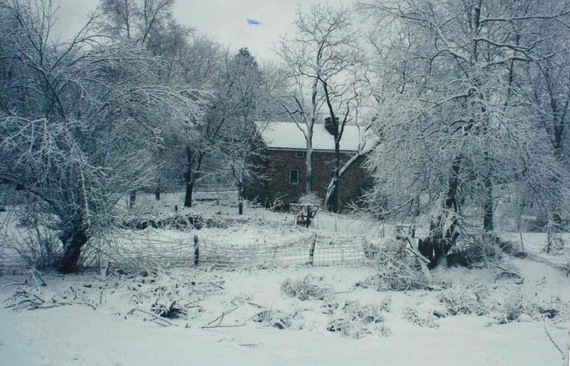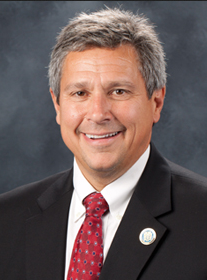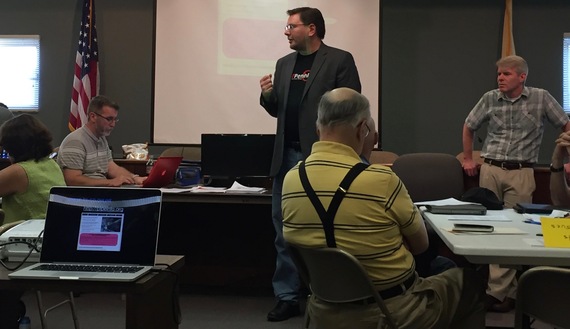On a routine workday in early summer, 2014 -- one month before the consortium of gas companies called PennEast, LLC. officially went public to announce their intention to build a 118-mile pipeline to transport fracked gas from the Marcellus Shale in Western Pennsylvania beneath the Delaware River through farms, wetlands, bedrock and preserved land to a terminus in near Trenton, New Jersey -- Susan Dodd Meacham received a phone call from her daughter.
"My daughter told me that a man had stopped by," says Dodd Meacham. "He gave her his card and asked if he could look around the property. She asked, 'Why?' And he said it had to do with a proposed gas pipeline.
Luckily, my daughter told him, 'No.'"
When Dodd Meacham got home, she called the man and learned that, without alerting her or any other landowner, the PennEast consortium had mapped out a route and planned to run a portion of the pipeline through her farm-assessed property in rural Hunterdon County not far from the Delaware River watershed. The Delaware River is one of the nineteen "Great Waters" recognized by America's Great Waters Coalition, and supplies drinking water to residents in New York, New Jersey and Pennsylvania.
"He asked again if he could just come look at our land. I told him only if he had a court order in his hand. The conversation ended amicably, but I thought I had made my point."
The next morning, Dodd Meacham heard a tapping at her door. "There stood the man," she says, shock still wavering her voice more than two years after the incident.
"He apologized for showing up unannounced and said I had been so nice on the phone that he just wanted to say hello and put a face to a name," she adds. "I didn't let him into the house - we stood on the front porch. He looked out over the back meadow, and said, 'Oh it's really nice back here. Did your father ever live here?'"
Dodd Meacham was dumbstruck. Her father had died when she was only six years old, shortly after the family had moved into a dilapidated stone grist mill that her mother eventually renovated and in which the family still lives.
"Not only did it stab me as any reference to the loss of my father, but I realized that this man and his company, PennEast, had gone to through county records and looked up details about our property. He must have known when it was purchased, and he knew that my father was deceased. It felt like a gut punch as I realized what a tremendous threat he and PennEast really were and how little regard they had for the community they intended to tear apart. I told the man that, 'No, my father had never been afforded the honor.'"
When the PennEast representative asked more questions about the property, Dodd Meacham deflected him. "My mother, in complete possession of her mental faculties at age 94, heard the conversation and joined us on the porch. The man said, 'Hi, you must be Vera.' My mother remained cool, putting him in his place by saying, 'I am Mrs. Dodd.'"
He jovially said, 'Oh, I hear you aren't happy about the idea of a pipeline.' And my mother made perfectly certain he understood she wasn't.
He then looked at me, and said, 'We aren't going to have a problem with this, are we?'
And I said, 'You can tell PennEast they are in for one hell of a fight.'"
One Hell of a Fight and What is FERC?
Senator Kip Bateman (R) 16th District, New Jersey &
Congresswoman Bonnie Watson Coleman (D) 12th District, New Jersey
Flash forward to August, 2016. Two years later, Dodd-Meacham, along with her neighbors in townships along the proposed pipeline route in Pennsylvania and every township along the route in New Jersey, are two years into putting up "one hell of a fight" against a pipeline that mounting evidence shows is not needed.
In addition, fracking, the gas produced from the process of fracking, and the Gold Rush-like proliferation of pipeline projects, have become national environmental issues. In the case of PennEast, questions about its merit and the process to approve it have garnered bi-partisan support in New Jersey from representatives including Congresswoman Bonnie Watson Coleman (D) and Senator Kip Bateman (R), both of whom have rejected the pipeline.
A year ago, Dr. Tullis Onstott, Professor of Geosciences at Princeton University - and in 2007 named one of TIME Magazine's most influential people in the world - testified that "PennEast pipeline's proposed path would blast a trench through the heart of a region with the highest arsenic concentration in the state of New Jersey. Onstott explained in detail how the arsenic trapped in the rock beneath the thin soil could be released leading to the loss of potable ground water that supplies rural and semi-rural communities who have no option for gas hook-up and therefore, "none of which would benefit from the fracked gas."
In spite of Dr. Onstott's testimony and reports from numerous scientists, the communities' fight took a dangerous turn when on August 1, at the height of summer vacation season, the Federal Energy Regulatory Commission (FERC), 1200-page Environmental Impact Statement, considered the first crucial step in the approval process for what experts are deeming an unnecessary, fast-tracked addition to an ever-growing pipeline construction boom; and allowing impacted communities only 45 days to respond.
According to FERC's website: FERC is an independent agency that regulates the interstate transmission of electricity, natural gas, and oil. FERC also reviews proposals to build liquefied natural gas (LNG) terminals and interstate natural gas pipelines as well as licensing hydropower projects.
But FERC's ethics have come into question on local and federal levels. In her own response to an outcry from her constituents over the "enormous shortcomings of FERC's process," Congresswoman Bonnie Watson Coleman proposed legislation to toughen FERC oversight and require the agency to examine public need and cumulative impacts of pipeline proposals.
Says Rep. Watson Coleman, "The recent proliferation of new pipeline proposals and their impact on communities raise serious questions about how many of these expensive fossil fuel infrastructure projects are actually needed and calls into question the rigor of FERC's review process. FERC must enforce a more cautious, holistic approach to considering these projects."
At the same time, residents and experts began to write their comments on the FERC PennEast comment docket. According to one comment: "The Environmental Impact Statement blatantly ignores Professor Onstott's Arsenic issues and incorrectly characterizes them as a construction-only activity. The issues identified by Dr. Onstott are on-going arsenic mobilization from the continuing operation of the pipeline. The EIS fails to recognize this and so is missing a vital impact to the community and region in regard to the safety of our drinking water".
"Under the National Environmental Protection Act, an EIS is required to seriously consider the "No Action Alternative".
(The No Action Alternative considers the baseline state of what would happen if the project were not constructed.)
The writer continues, "However, in the PennEast EIS issued by FERC, the No Action Alternative (that could stop the pipeline) is a bare four paragraphs in length. Within those four paragraphs, there is only a single citation made. That citation is to a list of shippers on the project. There is no mention that the majority of shippers are affiliates of the owners, and that FERC has ruled in past proceedings that affiliate shippers carry less weight than contracts with unrelated entities that serve as arms-length transactions."
The comment goes on to bring up one of the most important points missing from the Environmental Impact Statement: "There is no mention that they (PennEast) are lacking survey permission in over 70% of the route within New Jersey, and that there are strong indications that a certificate would in fact require eminent domain condemnation proceedings to be brought against 70% of the landowners or more."
Senators Elizabeth Warren and Ed Markey Question FERC on a PennEast Connection in Massachusetts


Senator Elizabeth Warren (D) Massachusetts &
Edward J. Markey (D) Massachusetts
Lawmakers and residents of Pennsylvania and New Jersey aren't alone in questioning FERC's ability to make informed decisions about the proliferation of pipeline proposals along the Eastern Seaboard and elsewhere through out the U.S.
On July 25, Massachusetts Senators Elizabeth Warren (D) and Edward J. Markey (D) wrote a letter to FERC pointing out that a contractor, Natural Resource Group, LLC (NRG), was hired in February, 2015, by FERC as a third-party contractor to review Spectra's Atlantic Bridge Pipeline Project, a proposed expansion of its existing Algonquin Gas Pipeline that runs through the Northeast US. At the time NRG was already working directly for Spectra who is a major partner in the PennEast pipeline project.
According to conflict of interest disclosure documents obtained by the website, DeSmog, from FERC through a Freedom of Information Act request, while NRG acknowledged it was working at the time directly for Spectra on other projects, it did not include its work on the proposed PennEast pipeline.
Spectra joined the PennEast consortium in October 2014. And while PennEast refuses to admit it, the PennEast Pipeline has the ability to interconnect to the Algonquin Gas Pipeline, which would boost PennEast's ability to deliver gas up and down the Eastern Seaboard and not solely for the needs of customers in New Jersey, whom they claim are woefully undersubscribed.
On June 14, the Senate Energy and Natural Resources committee held a hearing to examine oil and gas pipeline infrastructure and economic, safety and environmental, permitting, construction, and maintenance.
In his testimony, and in response to questions raised by Senator Elizabeth Warren, Jonathan Peress, Director of Air Policy, Environmental Defense Fund, said, "With the magnitude of the new pipeline projects under development in addition to those deployed over the past 10 years, there are signs that a gas pipeline capacity bubble is forming. A capacity bubble could impose unnecessary costs on energy customers for expensive yet unneeded pipeline capacity, and ultimately constrain deployment of lower cost energy sources like wind and solar..."
Gannett Newspaper Editorial in New Jersey Questions the Need for the PennEast Pipeline
On August 1, the Gannett Newspaper chain whose flagship paper is USA TODAY, posted an editorial in their New Jersey papers, saying,
The Federal Energy Regulatory Committee (FERC) has given the controversial PennEast pipeline project thumbs up in its much-anticipated environmental impact statement released last week.
No surprise there. FERC is pretty much in the business of approving pipelines, having never rejected one. So the fact that its assessment of environmental impacts found nothing of any great concern doesn't mean there aren't meaningful environmental problems. It just means FERC would prefer to ignore them, or in this case to suggest that potential problems can be easily mitigated with some project adjustments.
Meanwhile, the public has less than two months - the rest of the summer, basically - to digest a report of more than a thousand pages and provide public comment.
This has the feel of a rush job intended more to please PennEast and its partners rather than watching out for the public's best interest. But regardless, the pipeline remains an unnecessary danger to the state's drinking water.
...Connected to the project is the Southern Reliability Link that would cut through parts of the Pinelands. The project is being promoted as a boon to New Jersey consumers who would have easier and cheaper access to new natural gas supplies coming out of the Marcellus Shale in Pennsylvania. But be wary of such hyperbole. We hear the same thing for every pipeline proposal -- more capacity in the state means cheaper energy for us, hooray! But added capacity isn't always meaningful capacity; at some point companies will merely be competing amongst themselves for available supplies...PennEast has also failed to provide enough information on potential environmental impacts of the pipeline, according to critics of the FERC report.
Assemblywoman Elizabeth Muoio, D-Mercer, has called for an extension in the public comment period. That's the very least officials can do. Other obstacles remain before the PennEast pipeline becomes a reality. We urge opponents to pursue any available angle to block the project.
Just as important, however, is the broader goal of reining in the proliferation of pipeline proposals across New Jersey as the energy revolution unfolds. Fracking - hydraulic fracturing - has unlocked vast new natural gas and oil reserves, leaving companies scrambling to transport the product. While SOME new lines are in order, all of the proposals collectively would far exceed the need. But the approval process doesn't properly place the projects in any sort of context; they are considered in relative isolation, making each seem more important independently than it should.
New Jersey lawmakers are pushing for a bill that would toughen standards and mandate some of that additional perspective. We support that movement as well.
If any pipeline is going to threaten our water supply, it better be well worth it. The PennEast project isn't.
PennEast Responds to Gannett Op-Ed
Two days later, Patricia Kornick, spokesperson for PennEast, volleyed back, "The PennEast Pipeline," she wrote, "will lower energy costs for families and businesses in every corner of New Jersey, deliver clean, American energy that is better for our environment and create thousands of jobs during construction. One study found the region would have saved nearly $ 1 billion in both electric and gas bills in one recent winter."
"The winter Kornick continually refers to is the winter of the Polar Vortex in 2014," says Tom Gilbert, New Jersey Conservation Foundation (NJCF) campaign director for Energy, Climate and Natural Resources, "In fact, a recent analysis of actual gas flows during the Polar Vortex shows that several of the five interstate natural gas pipelines serving PJM East (the electric grid operator) never fully utilized their existing capacity, even though spot market gas prices skyrocketed.
The events from January 2014 cannot be used to justify the expansion of additional pipeline infrastructure," he added, "since policy changes to use existing pipelines more efficiently have already been successful in ensuring a reliable supply of gas."
Kornick continues, "With 90 percent of the future gas already under long-term contracts years before the PennEast Pipeline is approved and built, there's no question this project is needed and beneficial.
In a major milestone for the project, federal regulators have now agreed in an approximately 1,200-page report that this project can be constructed with minimal impact on the environment. That's great news for New Jersey.
Given the need and countless economic benefits, it's no surprise that every major business and labor organization in New Jersey and Pennsylvania supports its construction. It also has garnered significant bipartisan support from a long list of responsible elected officials.
Unfortunately, the Gannett New Jersey Editorial Board has fallen victim to special interest hyperbole. The recent editorial about PennEast "Stop the PennEast pipeline scam, Our View, is riddled with inaccuracies, exaggerated claims, and misstatements.
In particular, PennEast has spent the last two years seeking input from landowners, regulators, public officials and others to help refine the route and reduce impacts on the community and environment. The project anticipates almost another two years of additional multiagency, multistate environmental reviews.
Those collective efforts have been successful in improving the route. PennEast has implemented dozens of route modifications resulting from this feedback obtained through more than 250 meetings and thousands of public comments over the last two years. Equally important, the PennEast pipeline runs right next to existing overhead electric transmission lines on nearly half the route in New Jersey, significantly reducing the need for tree-clearing and minimizing disruptions.
The editorial's scare tactics about endangering drinking water are not only inflammatory, but false. Federal regulators examined the potential impacts on geology, soils, wetlands, vegetation and wildlife, air quality, noise, cumulative impacts and, yes, on water. In nearly every category, the Federal Energy Regulatory Commission found the project would not have significant impacts, or that impacts would be effectively minimized -- and that surface and groundwater impacts would be minimal."
But Gilbert counters, "The FERC draft report is missing enormous amounts of critical data on environmental resources and impacts. FERC has prematurely asserted that the impacts won't be significant in the absence of this data and public input. The fact is that the pipeline would cut through and damage more than 4,300 acres of tax-payer preserved open space and over 30 of the cleanest streams in New Jersey that supply drinking water to over 1.5 million people. Other key environmental agencies, including the Delaware River Basin Commission, Environmental Protection Agency and New Jersey Department of Environmental Protection, have yet to review the impacts PennEast would make on our natural spaces and resources.
Kornick has stood firm on the issue of air pollution, "With respect to cumulative impacts, FERC found they would be effectively limited, and that the pipeline could "contribute to a cumulative improvement in regional air quality if a portion of the natural gas associated with the Project displaces the use of other more polluting fossil fuels.
"It is impossible to evaluate cumulative impacts without sufficient data," he adds. "The White House Council on Environmental Quality just issued a final guidance on Green House Gases directing all federal agencies to review the climate impacts of federal projects. FERC and PennEast have not conducted such an analysis. PennEast would deliver 1 billion cubic feet of natural gas daily, a polluting fossil fuel that contributes to climate change through methane leakage and carbon emissions when burned."
Continues Kornick, "It's the simple forces of supply and demand that present real challenges for long-term energy reliability and cost -- not just yesterday, today or tomorrow, but decades into the future."
"PennEast represents a new form of market abuse since they are essentially manufacturing their own demand," counters Gilbert. "Over 70% of the contracts for the gas the pipeline would deliver are held by companies affiliated with the owners of the pipeline. A reputable energy research firm, Skipping Stone, concluded that this alone doesn't demonstrate public need or demand for the project."
In response to Kornick's claim that, "Federal regulators evaluated whether existing or proposed natural gas pipeline systems could meet the same objectives as the PennEast Pipeline Project while offering an environmental advantage. FERC found "there is no available capacity for existing pipeline systems to transport the required volumes of natural gas to the range of delivery points proposed by PennEast," Gilbert says that, "FERC's evaluation of alternatives is limited and flawed. This finding ignores expert analyses that found there is already more than 50% more pipeline capacity than needed by local gas distribution companies in the region PennEast is purported to serve, even in the harshest weather conditions."
Kornick concludes, "The state-of-the-art, American-made PennEast pipeline will safely deliver 1 billion cubic feet of clean natural gas every day. And while a balanced electric grid with solar and wind is important, it's absolutely essential to have reliable natural gas supplies to heat homes and businesses when the sun isn't shining and the wind isn't blowing.
We are encouraged that objective federal regulators agree that this project can deliver everyone lower energy costs, while protecting the environment. Readers should learn the facts at www.penneastpipeline.com."
But, Gilbert emphasizes that, "PennEast would not meet New Jersey's higher pipeline safety standards, so it is absolutely not state-of-the-art. Most New Jersey homes already have access to natural gas, and natural gas demand in the mid-Atlantic region is expected to decline or remain flat in the coming decades. Rather than developing more natural gas infrastructure, New Jersey should be investing in clean, renewable sources of energy like wind and solar."
Communities Gather to Comment on Environmental Impact Statement as FERC Deadline Draws Near
Mike Spille, TCOP; & Tom Gilbert, NJCF Advise Landowners on Replying to FERC's Environmental Impact Statement
Susan Dodd Meacham's neighbor, Bill Pandy, a third generation farmer, is as outraged and angry as she is. Pandy's great grandparents, who came from Hungary, bought and settled on their farm in 1925 after his great-grandfather felt "Black Lung setting in from working in the coal mines in western Pennsylvania."
On a warm August night, Pandy and fellow residents sit at tables in the Holland Township, New Jersey, municipal building, their laptops open as a team of neighbors and conservation experts helps them navigate through the Federal Energy Regulatory Commission's website in order to voice their objections.
Like Dodd Meacham, Pandy has been saying, "No," to PennEast. "Pretty much everyone in Kingwood and Holland Township has told them to stay off our property," he says. "When PennEast sent surveyors to our property without our permission, we asked them to leave, which they did, after they had already put their steel survey stakes in the ground."
Among Pandy's concerns with the FERC Environmental Impact Statement is the fact that Native Americans lived in the area beginning as early as the 9th century BCE and "we have found many Indian artifacts in the valley of our farm and that of our neighbor including a spearhead, a hand axe, and arrowheads.
The Environmental Impact Statement has a number of serious issues and deficiencies which means it does not accurately portray impacts to historical areas," he adds. "And a wholly inadequate replacement for a proper Section 106 process under the National Historic Preservation Act (NHPA)."
But Pandy has a second and more pressing reason to oppose the pipeline. In the 1950s, his grandfather signed an easement giving permission for the Buckeye consortium to build a pipeline through his property. The pipeline sits atop argillite, a form of shale that was widely used by the Native Americans to make their stone tools.
"Because our property sits on argillite," he says. "We've seen the problems with laying these lines. Storms fill creeks and the creeks change course and that affects the pipelines. We've also seen serious soil erosion around the pipeline, which has affected crops. Because Buckeye has an easement, they blasted a second trench 35 years ago. The rattling of the argillite was so bad it cracked our cellar wall. They never properly returned our soil, either. The argillite is so thick they had to set the pipeline on bedrock. When gas or diesel moves through a pipeline, it vibrates and you can feel it, and I've seen the Buckeye pipeline do it. The tar was rubbed off the pipe and the pipe came out egg -shaped. Plus, where the pipeline lay on the rock, the metal was shiny."
In the meantime, Dodd Meacham and Pandy are part of a growing movement across the U.S. where citizens and elected officials are questioning the process for which pipelines are proposed and approved.
"PennEast has consistently misled the public about the scope and purpose of this project," says Dodd Meacham. "Because this is an inter-state pipeline, the Federal Energy Regulatory Commission has oversight, and that has shown us all precisely how self-serving and beholden to the fossil fuel industry that quasi-governmental agency truly is. FERC is funded by the very industry it regulates, so its reputation as a rubber stamp agency for the industry is well deserved. And because of the revolving door that permits people who once worked for environmental companies to now work for pipeline companies, or, as regulators, the claims that the system is 'rigged' are well founded."
Meanwhile, residents along the proposed pipeline route in Pennsylvania and New Jersey have until September 12 to respond to FERC's Environmental Impact Statement.
Joy E. Stocke is founder and Editor in Chief of the online magazine, Wild River Review.
Follow Wild River Review on Twitter: www.twitter.com/WildRiverJoy




